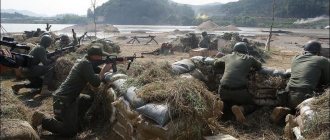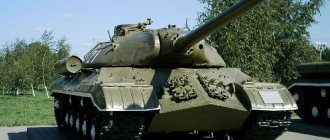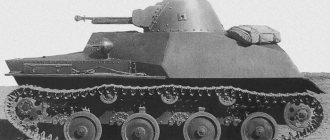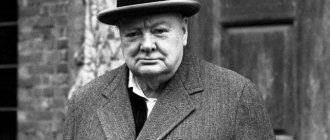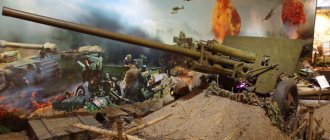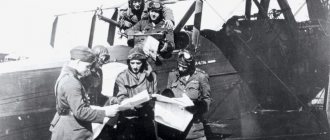Since the mid-1940s. In the top military leadership of the United States, voices were heard about the need for a radical re-equipment of the tank units of the American army.
The most consistent exponent of this point of view was Brigadier General M. Barnes.
It was he who came up with the idea of replacing the main tank unit of the American troops of that period - the M4 Sherman weighing 35 tons - with a more powerful and modern tank.
The reason for such harsh statements is the failure of American tank units in battles with German heavy tanks “Kingsteer” and “Panther” on the fields of France in 1944.
Barnes's arguments were heard by the US military elite.
In August of the same year, 1944, American engineers began developing prototypes of heavy tanks T29 and T30 (both vehicles weighed 70 tons).
It was planned to install 155 and 105 mm guns on the new tanks.
Photo 1. Experienced T29 heavy tank, armed with a 105 mm cannon
To manufacture the T29 cast hull, rolled armor plates with a maximum thickness in the frontal part of 102 mm were used; the turret received the strongest armor: in the frontal part - 177 mm, on the stern and sides - 102 mm.
A 105-mm T5E1 tank gun, which at that time was considered perhaps the most powerful in the world, was mounted on a carriage in the turret.
The armor-piercing projectile for the T29 tank had an initial speed of 914 m/s with a given mass of 34 kg.
This ammunition was able to penetrate a 135 mm armor plate with a thickness of about 135 mm, installed at an angle of 30°, from a distance of just under 1 km.
The chassis of the T29 prototype was similar to the serial M26, but due to the greater mass, the number of road wheels per side was increased to eight.
Amid the fierce fighting of early 1945, nearly 1,200 T29 heavy tanks were ordered to equip American tank divisions, as well as more than 500 T30 tanks to equip seven special tank battalions.
The collapse of Nazi Germany did not change anything in these production plans, since the heavy T29 was planned to be used during the invasion of the Japanese islands.
The surrender of Imperial Japan, which followed on September 2, 1945, after the nuclear bombings of Hiroshima and Nagasaki, and the end of World War II put an end to plans for the production of heavy tanks - the US Army quickly canceled its orders.
The prototypes of heavy tanks that had been built were no longer considered as standards for future mass production and over time began to be used simply as oversized stands for full-scale testing of new guns, engines and various equipment.
History of the creation of US tanks
In the USA, as in all other countries, the military initially reacted very coolly to the creation of tanks, especially since until the spring of 1917 they officially adhered to neutrality.
But among civilians this idea was very popular. For example, a certain K. Schafer, an American of German origin, approached the German consul with a project to create a single-seat armored vehicle based on a garden tractor; the consul did not like the idea. In 1915, simultaneously with proposals for the sale of M. Willock's tractors, businessman S. Lowe offered Willy Wilson ready-made drawings of a 30-ton armored vehicle based on the same tractors. There was no answer. Later, Willock and Lowe would accuse the British of copying heavy tanks from their drawings, but a commission specially created for this established the authenticity of the English invention.
In 1917, the tractor company introduced a machine similar in appearance to “Little Willie”: a box with tracks around the perimeter, a cannon in the bow compartment and machine guns in the sponsons. It is impossible not to mention the so-called “skeleton” - the tracked contours are connected by beams, and between them is a cubic armored cabin topped with a conical turret.
As often happens, they didn’t pay attention to their own samples, but fought to produce other people’s models. It was planned to produce 4,440 units of “6-ton tanks of the 1917 model”, the model was the Renault FT and 3,000 English Mk VIIIs, which were called “Liberty”. Until the end of the war, only 3 of the former were produced, and 7 of the latter.
Pacific Theater
The United States did not enter World War II immediately. The reason was the Japanese attack on Pearl Harbor. The declaration of war was late, so the Japanese attack is considered to be contrary to the principles of international diplomacy.
American losses on December 7, 1941 were:
- 230 aircraft;
- 8 battleships;
- 10 warships;
- 2403 military and ordinary citizens were killed.
The Japanese then lost only 29 aircraft.
The Pacific campaign lasted from 1941 to 45.
During military operations, Japan and America tried to seize dominance in this region. The turning point in favor of the Allies came in 1943. Jets and napalm were used. Japan surrendered only after a nuclear attack in August 1945.
US tanks during World War I
During World War I, the American military corps received from the allies not only material parts, but also a certain tactical concept of tank forces. According to it, troops should consist of light and heavy vehicles. Light ones for reconnaissance missions, and slow heavy ones for direct support of attacking infantry. This not entirely correct understanding led to a government act in 1920, which categorically prohibited the organization of tank forces. All work on improvement fell on the tank commission created under the chief of infantry.
Consequences - before 1935, only (!) 31 tanks were created and not a single production one. The created samples, hidden from the command, are handed over to the cavalry, but since the tanks must be accompanied by infantry, these are called “combat vehicles.”
It was the intervention of the cavalry that moved things forward; during maneuvers they clearly demonstrated the combat effectiveness of the unit only when used in combination. This is the official version, behind the scenes - we came to such conclusions while observing the exercises of the Red Army. Be that as it may, in 1932, the General Staff of the Ground Forces adopted a program for the mechanization of the army. It must be said that all tank samples that undergo standardization receive the letter “M”, and experimental models “T”.
Until the 40th, only the light tank M1 and medium M2 were put into service; later, developments on both tanks were used to create the medium M3. The design of the brilliant engineer W. Christie, which was used in tanks in many countries, was very popular with the military, but due to misunderstanding by the generals, only a few samples were sent to the troops.
Mediterranean theater of operations
The Americans did not fight alone in Italian and North African lands. They acted in concert with the British. Together they were able to overcome German-Italian resistance.
All sides suffered colossal losses. And the battles went on with varying degrees of success. The Italians were unhappy that their nation was being dragged into war. Therefore, Mussolini was arrested by order of the king in 1943. The Italian government enters into negotiations with the United States. But this fact was carefully hidden from Hitler.
In the summer of 1944, American soldiers from the Italian Front were sent to liberate Southern France.
So gradually the Mediterranean and Western European fronts were able to unite.
US tanks from World War II
In the summer of 1940, when war broke out in Europe, there were 300 light and 20 medium tanks in the US ranks; there were no heavy ones at all. The command already understood perfectly well that they would not be able to avoid being involved in this meat grinder. Having no developments in new tanks, the troops initially began to be equipped with only light and medium armored vehicles, and some went into production without even passing tests. The infantry breakthrough tank developed before the war, which received the M6 during standardization, became heavy.
Attempts to modernize old models lead nowhere, and a decision is made to create new models. The first tanks had weak armor and weapons; new models are trying to solve these problems primarily. The light M3 Stuart and the medium M3 Grant/Lee appear. But these tanks are also quite mediocre; they cannot compete on equal terms with German vehicles. After the appearance of the medium M4 Sherman, the situation changes somewhat.
The use of Tigers by the Germans forces the United States to produce the heavy M26 Pershing, which ended the M2 series. Simultaneously with the appearance of the M26, light tanks of the first model were replaced by the M24 Cheffi.
Before the end of the war, the Americans designed and produced M22 Locust airborne tanks and amphibious LVTs. Tank destroyers and anti-aircraft self-propelled guns were produced in large quantities. In total, during the war years, US industry produced 103,096 tanks and self-propelled guns.
Western European Theater of Operations
The American army almost never fought alone. For military operations in western Europe, the states attracted another ally - Canada.
USA in the Battle of the Atlantic
The Axis countries Berlin - Rome - Tokyo formed the Nazi bloc. The coalition sought to disrupt maritime communications between the allied countries. The most valuable cargo was sent across the Atlantic. Consequently, if the delivery of food and weapons is stopped, then the starving soldiers will have nothing to fight with.
Germany has focused on submarines
They became a thunderstorm of the ocean due to their ability to approach almost silently. Most often, German submarines attacked single small ships.
Therefore, the Allies began sending convoys across the Atlantic with a serious defense system. As a result, there was one German submarine for every Allied ship sunk.
American bombing of the Third Reich
Carpet bombing using incendiary bombs destroyed most German cities. Even small settlements were not spared. It was important to destroy residential areas and industrial facilities. Because they also played their role in the war along with the soldiers.
Over the entire period, about 80 million incendiary bombs were dropped
About 600 thousand people were destroyed. Most residents survived by hiding in bomb shelters. But according to some reports, charred corpses were retrieved from the basements of German cities until 1947.
Second front
American soldiers arrived on the Western European front only in 1944. The joint operation of Canada, America and England went down in history as D-Day or Overload. It ended with the liberation of Paris and France from the German occupiers. Only by December were the troops able to approach the French-German border. The reason for the slow progress was bad weather.
From December 1944 to April 1945, the combined Allied forces captured almost all German territory up to the Rhine, crossed the river and met the Soviet army on the Elbe.
Modern US tanks
Based on combat experience, the American command in 1946 adopted an extensive program for improving tanks and their units. Mandatory conditions were: reduction in size, weight and standardization of spare parts in order to increase the ability to use tanks in a wide variety of climatic zones and terrain conditions with a minimum use of additional devices, to increase the ease of field repair and maintenance in general, as well as to achieve savings in the manufacture of tanks . The assigned tasks determine the features of future combat vehicles.
The troops planned to use light, medium and heavy tanks. The light ones were intended for reconnaissance and airborne troops, as well as for security use. In order to increase mobility, they had bulletproof armor and weapons sufficient for self-defense. The M1 Walker Bulldog is used for these purposes. The M46 Paton medium tank becomes the main medium tank, and the last heavy American tank becomes the M103.
The experience of combat operations in the conflicts of the 50s shows that the characteristics of the first generation tanks do not correspond to the new military requirements: they cannot conduct aimed fire on the move, with their large weight and large dimensions they cannot be air transported (M21), they have poor protection from radioactive radiation and shaped charges , rather limited power reserve, etc. Analyzing the above problems, a new qualification appears, no longer in terms of weight, but in terms of firepower. Tanks began to be divided into light-cannon, medium-cannon and heavy-cannon.
The tank building program adopted by the United States in 1957 consisted of two parts. The first part implied the creation of three types of tanks:
- Light cannon for reconnaissance and combat security.
- Improved medium cannon (main type).
- Heavy guns for fighting enemy tanks.
During the second, longer stage, it was planned to create two types of tanks:
- Combat (main).
- A new type of reconnaissance air transport tank.
During the implementation of the first part of the program, the light M55 Sheridan and the medium M47 Paton II are replaced.
Without waiting for the end of the second stage, in the early 60s, military theorists proposed a new concept for the use of tanks, and, accordingly, a new qualification in accordance with their combat purpose. According to the new theory, there should be three types of tanks:
- for fighting,
- for protection,
- for reconnaissance.
The “battle tank” is maneuverable, well-armored and, most importantly, has powerful weapons for firing at the enemy in any conditions. The “reconnaissance tank” must be characterized by high mobility and have reliable long-distance communications. To combat enemy tanks, a “guard tank” must first of all have powerful cannon armament.
Based on the listed requirements, since 1960, medium and light tanks have been replaced by the main combat M60, and infantry armored vehicles have been used for reconnaissance purposes.
After 1980, the third generation M1 Abrams tank became the main battle tank.
Military production
The United States experienced an unprecedented increase in military production during World War II. Basically all goods went overseas. Americans spent little on luxury goods, preferring to save money. Nobody believed that the war would last forever. And after the end of military orders, an economic recession was likely.
First of all, America’s territorial remoteness from the theater of operations contributed to its success.
No one bombed industrial areas. Only 11 million Americans were drafted. The country still has workers, engineers, and resources. Thus, the American Labor Front was able to provide significant assistance to the Allied troops.
Henry Kaiser's enterprises built 3 ships a day. Thanks to rational innovations, they were able to shorten the production cycle. By the end of the war, a total of 2,770 units were built. transport type "Liberty". The Germans did not have time to sink as many ships as they produced in American shipyards.
Henry Ford received a contract to produce strategic bombers. Automotive industry technologies were used to reduce the cost and speed up production.
Despite complaints from soldiers that the B-24 was inferior in protection to the Flying Fortresses, Ford switched production to 24-hour operation. Every month its factories produced about 600 bombers.
US serial tanks
| Name of the tank | Released |
| M1 | 1934 |
| M2 | 1935 |
| M3 Stewart | 1940 |
| M3 Grand | 1941 |
| M6 | 1941 |
| M22 Locust | 1942 |
| M5 Stewart | 1942 |
| LVT | 1943 |
| M4 Sherman | 1943 |
| M24 Chaffee | 1944 |
| M 26 Pershing | 1945 |
| M 46 Paton | 1948 |
| M41 Walker Bulldog | 1951 |
| M47 Paton II | 1951 |
| M47 Paton III | 1953 |
| M103 | 1956 |
| M60 | 1959 |
| M1 Abrams | 1980 |
| Stingray | 1984 |
| TSM | 1985 |
More material on the topic
- M4 Sherman
- New deadly tank T90MS
Consequences
Other countries and the United States were in different conditions after World War II. Nobody bombed America. All factories remained intact. Against this background, the states increased their economic, political and military influence in the world.
During World War II, the United States finally emerged from the Great Depression. Growing production required workers. Consequently, unemployment is a thing of the past. Thanks to patriotism, people worked much more. Salaries have increased.
The redistribution of capacities between industries played a role. Highly productive enterprises came to the fore. The quality of work increased. New technologies appeared that contributed to the growth of production and sales. Women went to work in factories.
Reasons for America's strengthening on the world stage:
- Small losses amounting to $1.2 billion. In turn, this is approximately 0.4% of all losses during the war.
- America sold weapons, raw materials, equipment and agricultural products. The total revenue amounted to about $46 billion.
- It was then that the dollar became a world currency, and 65% of gold reserves ended up in American vaults.
- The power of the US Navy has increased 5 times.
- The average annual growth in industrial production was 15%.
- By 1947, American production captured more than half of the world market.
The famous “Alaskan Highway” arose due to the Japanese threat.
It was not built the first time. Because weather conditions did not allow us to immediately lay a durable asphalt surface. After the end of the war, the highway became the property of Canada and operates to this day.
Return of the troops
By the end of the war, there were about 8 million military personnel abroad. Their return to their homeland took place as part of Operation Magic Carpet. It took an average of one year.
The first soldiers sailed from Europe in June 1945.
Military personnel from the Pacific took the longest to be recalled. The last of them returned home in September 1946.
Hall of Fame
After the end of World War II, the United States was summing up its results. Heroes were awarded the Medal of Honor. Memorials were erected to commemorate achievements and losses.
Famous generals
Douglas MacArthur
Douglas MacArthur commanded the Allied forces in the Philippines and participated in their defense until the surrender. He then led the counter-offensive in New Guinea. It was under his leadership that the army was able to recapture the Philippines from Japan.
Henry Harley Arnold
Henry Harley Arnold was involved in aviation. Thanks to his persistence, the number of aircraft increased, and the Air Force was separated into a separate branch of the military. It was Arnold who planned all the attacks of American aircraft during the Second World War.
Dwight David Eisenhower
Dwight David Eisenhower commanded the offensive on the Mediterranean front and led the landings in Normandy. He was also responsible for the deaths of German prisoners of war after the end of the war. On his initiative, a class of prisoners was created who were denied simple living conditions, contrary to the Geneva Convention.
George Smith Patton
George Smith Patton is known for his cruelty and controversial statements. But he knew how to strictly maintain discipline. He took part in the Mediterranean and Western European fronts.
Omar Nelson Bradley
Omar Nelson Bradley served on the Mediterranean front. Thanks to his resourcefulness, Messina was captured in just 5 weeks. At the same time, he saved a large number of his people from death. He also commanded the 1st Army in Normandy. It was under his command that the troops broke through the Siegfried Line and crossed the Rhine.
George Catlett Marshall Jr.
George Catlett Marshall Jr. was Roosevelt's adviser on strategy and tactics. Not a single allied conference could take place without his participation.

